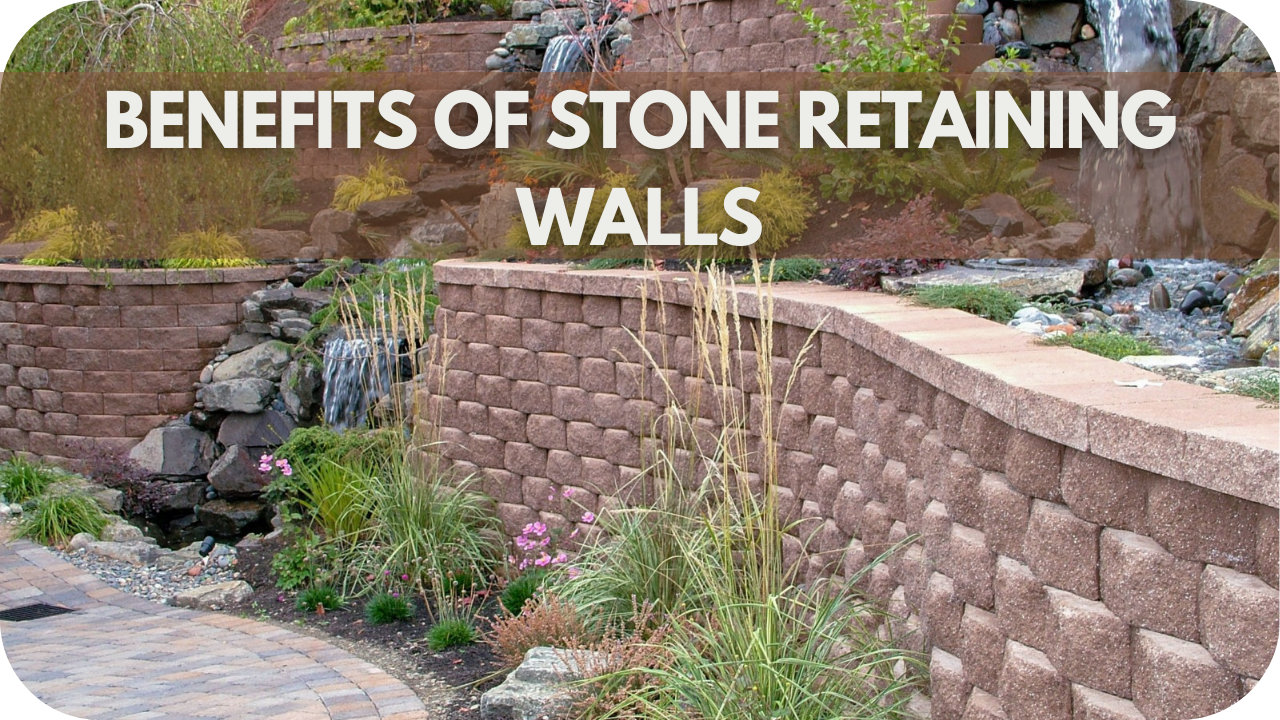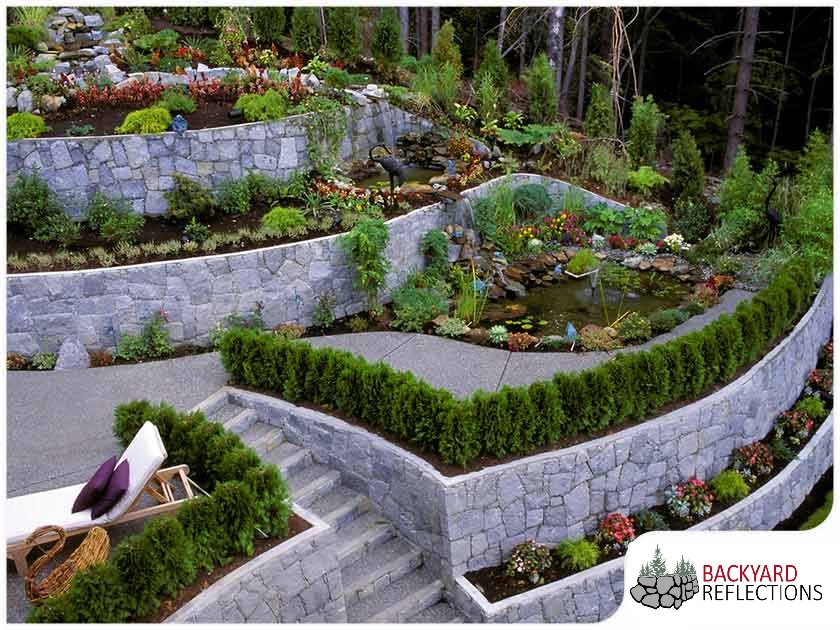Here’s why OKC Precision Retaining Walls are essential for stabilizing uneven land
Here’s why OKC Precision Retaining Walls are essential for stabilizing uneven land
Blog Article
Secret Considerations for Structure Effective Retaining Walls in Your Lawn
When you're considering constructing a maintaining wall surface in your backyard, it's essential to believe concerning numerous key elements. The wall's objective, the materials you'll make use of, and the particular soil problems can all impact its effectiveness and long life.
Comprehending the Function of Your Retaining Wall
When you assume concerning developing a keeping wall surface, consider its main purpose: maintaining soil and preventing erosion. Retaining walls give vital assistance for sloped landscapes, assisting to keep soil integrity. You'll discover they're essential in areas where water runoff might otherwise get rid of soil, causing costly repair work and landscape damages.
By keeping back planet, these walls create level surfaces for gardens, patios, or pathways. This not only boosts your backyard's visual appeals however additionally advertises much better drain, decreasing water merging in undesirable areas. If you're managing high inclines, a well-constructed retaining wall can stop landslides, guaranteeing security for you and your building.
Ultimately, understanding the objective of your retaining wall will assist your design decisions and assist you produce a practical, long lasting framework that satisfies your requirements. So, take a moment to examine your landscape; it'll repay in the long run.
Picking the Right Products
When picking materials for your retaining wall, you'll wish to consider toughness, aesthetics, and cost. Each factor plays an essential role in ensuring your wall surface stands the test of time while looking fantastic and fitting your spending plan. Let's explore just how to make the most effective options for your project.
Product Toughness Variables
Selecting the right materials is crucial for the long life and effectiveness of your retaining wall surface, since their toughness directly influences the wall surface's capacity to withstand ecological anxieties. Begin by considering your neighborhood environment; products like concrete and stone resist wetness and temperature variations well. If you reside in an area vulnerable to heavy rains, opt for materials with excellent water drainage homes, like gravel or porous blocks, to stop water buildup.
Some materials perform far better in particular soil types, so it's vital to match them appropriately. Selecting sturdy products warranties your retaining wall surface stands solid, shielding your lawn for years to come.
Aesthetic Style Choices
Long lasting products not just guarantee your retaining wall's structural stability but likewise play an essential function in its visual allure. When picking the appropriate products, think concerning just how they complement your landscape. All-natural rock supplies a classic, rustic look, while concrete blocks can give a sleek, modern surface. You may likewise think about using wood for a cozy, natural feeling. Shade and appearance matter, also; select shades that integrate with your home and yard. Don't forget about the wall surface's shape-- rounded walls can produce a softer appearance, while straight lines can feel a lot more structured. By very carefully picking materials that straighten with your aesthetic vision, you'll improve your exterior area while guaranteeing your wall surface stands solid versus the aspects.
Cost-Effectiveness Evaluation
Selecting the best materials for your retaining wall surface isn't simply concerning aesthetic appeals; it's likewise essential for your budget. When choosing products, take into consideration both ahead of time costs and long-term resilience.
Don't forget to consider maintenance prices as well (OKC Precision Retaining Walls). Some materials, like natural stone, can add charm and call for much less maintenance, while others may need normal therapies
Ultimately, weigh the advantages and disadvantages of each alternative against your spending plan and the wall's designated purpose. Investing sensibly in products now can protect against pricey issues later on. Pick products that stabilize cost and performance successfully.
Evaluating Dirt Problems and Drain
As you begin your job, evaluating soil problems and drain is essential for the success of your retaining wall surface. Begin by analyzing the kind of soil in your yard. Sandy soil drains well yet does not have security, while clay soil can retain moisture, causing pressure on your wall. Examine the dirt's moisture web content by excavating a tiny opening and observing exactly how promptly it dries.
Next, analyze the slope of your backyard. If water naturally streams towards your wall surface, you'll need to implement a water drainage remedy to stop disintegration and stress buildup. Take into consideration installing perforated pipes or crushed rock backfill behind the wall to help with water drainage.
Lastly, observe any kind of nearby trees or plants; their roots can influence dirt stability. By recognizing your dirt conditions and carrying out correct water drainage, you'll create a strong foundation for your retaining wall surface that stands the examination of time.
Following Local Building Ordinance
Before you start constructing your retaining wall, you require to research local laws to guarantee conformity. It's important to recognize what permits you should get, as this can save you from pricey penalties or needing to remodel your work. Taking these steps seriously will help you construct a risk-free and efficient framework.
Research Local Regulations
Recognizing local go to website guidelines is vital when planning your retaining wall job, particularly considering that constructing codes can differ substantially by area. Begin by talking to your regional structure department or municipality to find out about particular needs. Try to find guidelines on wall surface elevation, products, drain systems, and structural stability. Numerous areas have limitations on the kinds of products you can make use of and how high you can develop. You'll also intend to consider the zoning regulations that may influence your job. Neglecting these policies can result in expensive fines or the demand to renovate your job. By doing your research upfront, you can assure your retaining wall fulfills all essential codes and blends effortlessly right into your yard.
Get Essential Licenses
When you have actually looked into neighborhood guidelines, the next action is to obtain the needed authorizations for your retaining wall job. This procedure assurances your wall follows building regulations and safety and security criteria. Get to out to your regional structure authority to discover what permits you require. They may require particular strategies or engineering evaluations, especially for larger walls. Be prepared to submit detailed illustrations, consisting of measurements and products. Do not neglect to inspect if your task influences drain or bordering homes, as these variables might call for added licenses. Securing the ideal approvals can conserve you from pricey fines or having to dismantle your wall later on. Keep in mind, following the regulations currently will cause a smoother building experience.

Planning the Layout and Visual Appeal
As you start planning the layout and visual appeals of your retaining wall surface, consider just how it will balance with the bordering landscape. Think about the products you'll utilize-- rock, block, or concrete-- and exactly how they'll enhance your home's style and the natural environments in your lawn. Pick shades and appearances that blend perfectly with existing attributes like patio areas, pathways, or gardens.
Next, visualize the wall's form and height. Rounded walls can soften an inflexible landscape, while straight lines might communicate an extra modern look. Do not fail to remember to integrate plants and greenery around the wall surface for an all-natural touch; this top article can enhance its charm and integrate it right into the environment.
Last but not least, remember functionality. Your design must not only be visually pleasing but also serve its purpose successfully. By attentively planning these elements, you'll develop a retaining wall surface that enhances your yard's elegance while satisfying its structural function.
Determining Height and Thickness Demands
To develop a strong retaining wall surface, you require to accurately compute its height and thickness demands based upon the dirt problems and the height of the incline it will support. Beginning by assessing the slope's angle and the kind of soil, as various dirts exert varying amounts of stress.
For walls over four feet high, think about a density of at least 12 inches. If the wall is taller, raise the density proportionally to keep security.
Next, determine the elevation of the wall by measuring the vertical range it requires to maintain. For every foot of elevation, you must normally prepare for a thickness of one-third of the wall surface's elevation.
Always bear in mind to make up extra aspects like water drainage and backfill, which can affect your wall's design. Appropriate computations currently guarantee your retaining wall surface stands strong and lasts for many years ahead.
Upkeep and Long Life Considerations
While preserving your retaining wall surface could feel like a low priority, ignoring it can cause substantial concerns with time. Normal evaluations are important; look for fractures, bulges, or any indicators of water damages. Addressing these troubles early can save you from costly repair work later on.
Keep an eye check on drainage systems, as well. Obstructed drains pipes can cause water to develop up, exerting pressure on your wall surface and endangering its security. Clear particles and warranty proper circulation to maintain longevity.
You might likewise desire to review sealing your wall to safeguard it from moisture and weathering. Depending upon the material, this could need reapplication every few years.
Lastly, landscape design around your wall surface can support its honesty. Stay clear of growing large trees nearby, as their roots can weaken the foundation. With aggressive maintenance, your retaining wall surface can serve you well for years ahead.

Frequently Asked Inquiries
Can I Develop a Retaining Wall by Myself, or Should I Hire an Expert?
You can certainly build a preserving wall surface on your own if you have the right tools and expertise. However, hiring a specialist assurances it's done appropriately, especially for bigger or more complicated structures. Consider your ability degree prior to choosing.
What Are one of the most Common Mistakes Made When Building Retaining Walls?
When constructing retaining walls, you may overlook correct drainage, avoid using the appropriate products, or disregard support. These common errors can cause architectural failure, so take your time and plan carefully to prevent issues.
Exactly how Do I Know if My Retaining Wall Needs Reinforcement?
You'll recognize your retaining wall surface requires reinforcement if you notice splits, leaning, or bulging. Inspect for water merging behind it or dirt disintegration near the base. Address these indications immediately to avoid additional damages.
What Plant kingdom Appropriate for Landscaping Around a Retaining Wall?
When landscaping around a keeping wall, consider using low-maintenance plants like succulents, ornamental lawns, or sneaking ground covers - OKC Precision Retaining Walls. They'll grow in those conditions and add charm while avoiding dirt disintegration around your wall
Just How Can I Prevent Erosion Around My Retaining Wall?
To avoid erosion around your retaining wall surface, you can grow ground cover, usage mulch, and set up water drainage systems. On a regular basis inspect for water build-up and adjust landscape design to redirect runoff far from the wall.
Report this page